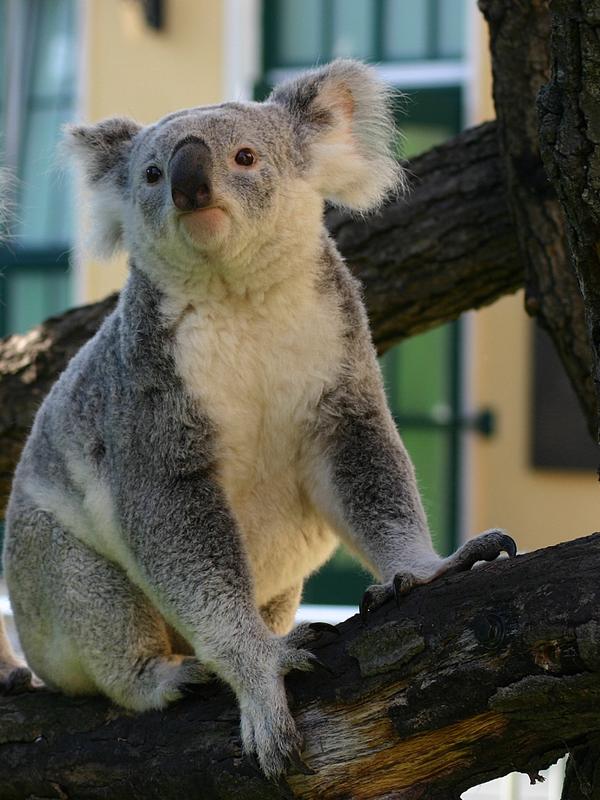Koalas have a funny diet – do they have funny bacteria?

Koala Barbara Feldmann, IZW
The study also demonstrates that non-invasive samples such as faecal samples commonly used to assess the composition of microbial communities may not provide an accurate account of the host gut microbiome. The study has just been published in the scientific journal “Scientific Reports”.
The koala (Phascolarctos cinereus) is an arboreal marsupial that has a unique diet consisting almost exclusively of Eucalyptus leaves. Eucalyptus foliage has been described as an “unpromising” dietary source for being low in nutrients but rich in compounds which are toxic to most animals.
Bacteria are thought to play an important role in the digestion of Eucalyptus leaves. However, whether such an exclusive diet influences the composition of koala bacterial communities, or microbiomes, is unknown.
An international team of scientists from the Department of Wildlife Diseases of the Leibniz Institute for Zoo and Wildlife Research (IZW) in Berlin, Germany, University of the Sunshine Coast (Australia), University of Illinois at Urbana-Champaign (USA) and Vienna Zoological Garden characterised the koala microbiomes using next generation sequencing.
The scientists found that koala oral and gut microbiomes were similar in composition to the microbiomes from the same body regions of other mammalian species. Therefore the unique diet of koalas does not seem to influence koala microbial communities inhabiting digestion-associated organs. Furthermore, rectal swabs and faeces were compared, for the first time using high-throughput sequencing, in order to understand whether these two sample types are equivalent in describing koala gut microbiome.
Rectal swabs contained all of the diversity present in faecal samples, along with additional taxa, suggesting that faecal bacterial communities may only represent a subsample of the complex bacterial communities inhabiting the gut. Moreover, the faecal microbiomes of the captive koalas from this study were compared with existing data on wild koalas to understand whether captivity results in major alterations of koala gut microbiome.
The results showed that the profile of captive and wild koalas were similar, suggesting that captivity may not compromise koala microbial health. Because koalas frequently suffer from ocular diseases caused by Chlamydia infection, the microbiome of the koala eye was also examined. This microbial community was very diverse, similar to other mammalian ocular microbiomes but with an unusually high representation of bacteria from a family not observed in other mammals.
Further research will be needed to determine whether this influences the susceptibility of koalas to infections by Chlamydia. This is the first study describing the composition of the eye microbiome of a non-human mammal by high-throughput sequencing and it establishes the healthy baseline for this body part to which microbiomes of diseased states can be compared.
Publication:
Alfano N, Courtiol A, Vielgrader H, Timms P, Roca AL, Greenwood AD (2015): Variation in koala microbiomes within and between individuals: effect of body region and captivity status. SCI REP. Doi: 10.1038/srep10189.
Contact:
Leibniz Institute for Zoo and Wildlife Research (IZW)
Alfred-Kowalke-Str. 17
10315 Berlin
Germany
Niccolò Alfano
Tel.: +49 30 5168-455
alfano@izw-berlin.de
Steven Seet
Tel.: +49 30 5168-125
seet@izw-berlin.de
Media Contact
All latest news from the category: Life Sciences and Chemistry
Articles and reports from the Life Sciences and chemistry area deal with applied and basic research into modern biology, chemistry and human medicine.
Valuable information can be found on a range of life sciences fields including bacteriology, biochemistry, bionics, bioinformatics, biophysics, biotechnology, genetics, geobotany, human biology, marine biology, microbiology, molecular biology, cellular biology, zoology, bioinorganic chemistry, microchemistry and environmental chemistry.
Newest articles

NASA: Mystery of life’s handedness deepens
The mystery of why life uses molecules with specific orientations has deepened with a NASA-funded discovery that RNA — a key molecule thought to have potentially held the instructions for…

What are the effects of historic lithium mining on water quality?
Study reveals low levels of common contaminants but high levels of other elements in waters associated with an abandoned lithium mine. Lithium ore and mining waste from a historic lithium…

Quantum-inspired design boosts efficiency of heat-to-electricity conversion
Rice engineers take unconventional route to improving thermophotovoltaic systems. Researchers at Rice University have found a new way to improve a key element of thermophotovoltaic (TPV) systems, which convert heat…



